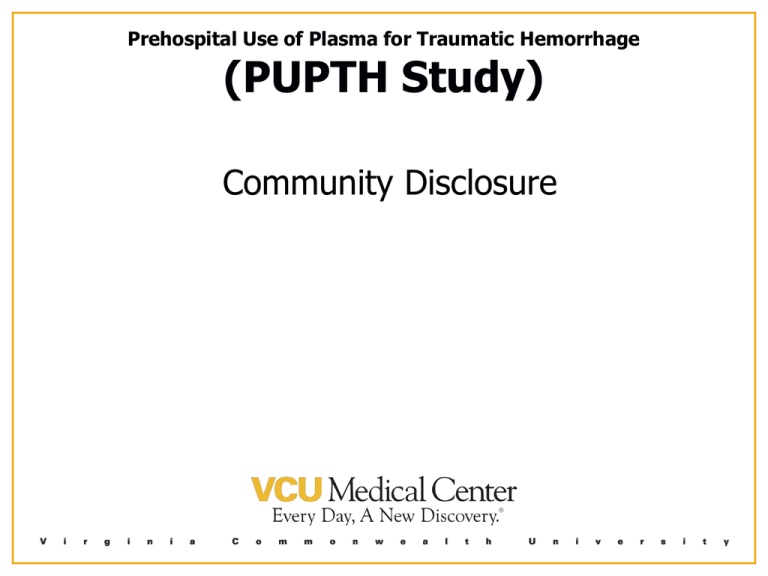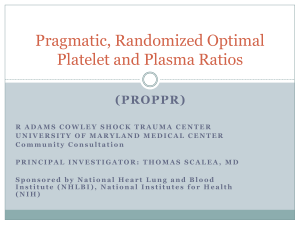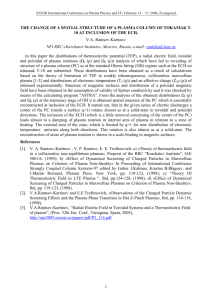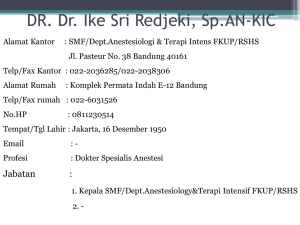View the plasma study presentation
advertisement

Prehospital Use of Plasma for Traumatic Hemorrhage (PUPTH Study) Community Disclosure Clinical Investigators Principal Investigator Bruce D Spiess, MD Professor, VCU Department of Anesthesiology Researcher VCU Reanimation Engineering Science Center (VCURES) Sub-Investigators Michel Aboutanos, MD Donald Brophy, PharmD, MSc Paula Ferrada, MD Christopher Hogan, MD Ajai Malhotra, MD Joseph P Ornato, MD Kimberly W Sanford, MD James F Whelan, MD Rahul Anand, MD Harinder Dhindsa, MD Stephanie Goldberg, MD Sudha Jayaraman, MD Julie Mayglothling, MD Susan D Roseff, MD Jacob Wegelin, PhD Brandon Wills, DO, MS Study Sponsor Funded by a grant from the U.S. Army Medical Research and Material Command Combat Casualty Care Research Program Study Purpose To see if patients who receive plasma as soon as possible after suffering a non-head related trauma have… Less – Bleeding – Need for additional blood – Pain Better clinical outcomes Improved survival rates Need for Improved Outcome The Center for Disease Control (CDC) lists trauma as the leading cause of death among Americans under age 45 Uncontrolled bleeding is the leading cause of death from trauma Thousands of trauma patients die each year Many of these patients die because the “standard of care” cannot reverse the damage from too much blood loss What is the Standard of Care? Represents the current treatment At the Site of Injury or In the Ambulance The patient receives salt water In the Hospital The patient receives salt water and donated parts of blood Standard of Care Limitations At the Site of Injury or In the Ambulance Salt water does not carry blood or its parts such as plasma (part of the blood that causes it to clot) Salt water can dilute the blood too much If there is too little or no plasma – Blood cannot clot which leads to more bleeding – Organs can stop working – Patient can bleed to death Standard of Care Limitations In the Hospital Patients who receive more than 6 units of donated blood in the first 12 hours have an increased risk of organ failure Increased blood transfusions weaken patient’s normal immune state Why Giving Plasma at the Site or In the Ambulance Could Help To improve survival of severely injured and bleeding patients Experience of Giving Plasma Early Plasma has been shown in pre-clinical studies… – To be better than salt water or other solutions that help get blood to the body’s organs – To nearly equal fresh whole blood in preventing excessive bleeding or total blood loss. Plasma has been shown to be safe in the hospital for victims of trauma Giving plasma early has improved survival Trauma accounts for approximately 8-12% of the blood usage in the United States. Giving plasma earlier in the treatment may reduce the demand for blood that would have great benefit on the blood supply as a whole. Trial Design: Before the Hospital Severely injured trauma patients will be randomized to either one of two groups Control 50% Receive salt water (as needed to maintain blood pressure) Test 50% Receive up to 2 units Plasma plus salt water (as needed to maintain blood pressure) Trial Design: At the Hospital Control Test Salt water for hydration Salt water for hydration Donated blood products including plasma per standard of care Donated blood products including plasma per standard of care Who Would Be Included? Patients at risk of dying who… Have sustained severe injuries Have lost a large amount of blood and have either – very low blood pressure or – low blood pressure and high heart rate Are at least 18 years old Are of either gender (male or female) Who Would Be Excluded? Anyone wearing an opt-out wrist band Any patient or next of kin (who understands) refusing participation Less than 18 years old (i.e. is a minor) Patients not expected to survive transport to VCUMC Documented “Do Not Resuscitate Order” Patients who have penetrating brain injuries Patients known to be pregnant Prisoners Patients who cannot speak English or Spanish Patients who require CPR Patients for whom EMS cannot start an IV line Patients not having low blood pressure or who are easily treated for low blood pressure Patients with known objections to blood transfusions What is Informed Consent? A process by which patients make informed decisions about participating in research studies – Traditionally required for all research studies – Research studies compare 2 treatments (standard vs. investigational) – Doctors or research staff describe each of these potential treatments – Patients are informed of the potential risks and potential benefits associated with each of these treatments – Patients choose whether to participate in the study What is Exception from Informed Consent? Patients are enrolled in a research study without giving their informed consent How Can That Be? A federal regulation (21 CFR 50.24), created in 1996, allows certain studies that meet the following criteria to use this exception – Patients’ lives must be at risk – Available treatments are not satisfactory – Patients are unable to give consent – Potential risks are reasonable – Participation in the research could provide a direct benefit (increased survival) to the patient – The research could not be practicably carried out without an exemption Consent Safeguards If possible, the patient or a legally authorized representative (LAR)/adult family member can refuse before the patient is enrolled in the study If refusal cannot be obtained before enrollment, frequent attempts will be made to contact the patient’s LAR or adult family to describe the study The patient, a legally authorized representative, or adult family members may decide to withdraw the patient at any time Potential Benefits of Giving Plasma Early Giving plasma early may provide improved survival Giving plasma earlier in the treatment may reduce the demand for blood that would have great benefit on the blood supply as a whole Could be used as guide for military combat use Potential Risks of Giving Plasma Early Allergic reaction Inflammation Infection Difficulty breathing Unforeseen happenings Patient Protection The Institutional Review Board (IRB) is a group of medical, scientific, and nonscientific members of the community – Reviews all proposals for research on humans – Assures patient safety – Monitors community feedback The IRB and U.S. Food and Drug Administration (FDA) will decide whether or not to allow this hospital to participate in the PUPTH trial An independent data monitoring committee will oversee the trial The FDA will be kept informed of the trial’s progress Please Note… Those who do not want to participate in the study can wear a special wrist band to exclude themselves (opt-out) The study is expected to last through 2016. The results of the study will be revealed to the community after the trial has been completed Questions or Comments?











